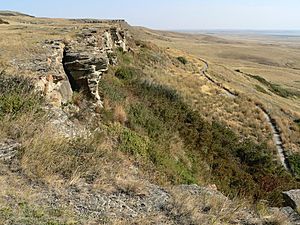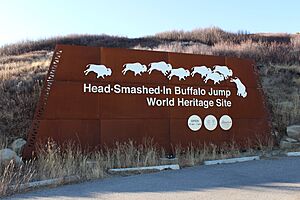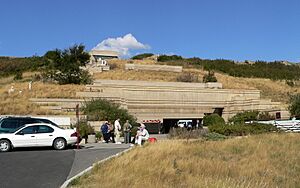Head-Smashed-In Buffalo Jump facts for kids
Quick facts for kids Head-Smashed-In Buffalo Jump |
|
|---|---|
| Native name Blackfoot: Estipah-skikikini-kots / Áístipahskikikínikots |
|

The cliffs at Head-Smashed-In Buffalo Jump
|
|
| Location | Municipal District of Willow Creek No. 26 near Fort Macleod Alberta |
| Area | 73.29 square kilometres (28.30 sq mi) |
| Founded | 1955 |
| Governing body | Alberta Community Development |
| Type | Cultural |
| Criteria | vi |
| Designated | 1981 (5th session) |
| Reference no. | 158 |
| Country | Canada |
| Region | North America |
| Official name: Head-Smashed-In Buffalo Jump National Historic Site of Canada | |
| Designated | 1968 |
| Type | Provincial Historic Site |
| Designated | 1979 |
| Lua error in Module:Location_map at line 420: attempt to index field 'wikibase' (a nil value). | |
Head-Smashed-In Buffalo Jump is a special place in Alberta, Canada. It's a museum that teaches about the Blackfoot people and their history. This amazing site is also a UNESCO world heritage site, which means it's important to the whole world! It's located about 18 km (11 mi) west of Fort Macleod, where the Rocky Mountains start to rise from the flat prairie land.
A wise elder named Joe Crowshoe Sr. (Aapohsoy’yiis), from the Piikani Nation, helped a lot with this site. He worked hard to keep the Aboriginal culture alive and to build good relationships between different groups of people. In 1998, he received a special award for "saving the knowledge and practices of the Blackfoot people." The Joe Crow Shoe Sr. Lodge at the site is named in his honor.
Contents
How the Buffalo Jump Worked
For 5,500 years, the indigenous peoples of the plains used this buffalo jump to hunt bison. They would drive large herds of bison off an 11-metre-high (36-foot) cliff. Before horses arrived, the Blackfoot people would guide the bison from their grazing areas. These areas were about 3 kilometres (1.9 mi) west of the cliff in the Porcupine Hills.
Guiding the Bison
Special "buffalo runners," who were young men, would dress up like coyotes and wolves. They knew a lot about animal behavior. They would slowly guide the bison into long "drive lanes." These lanes were marked by hundreds of small piles of rocks called cairns.
The Jump and the Hunt
Once the bison were running fast, the weight of the herd behind them would push them over the cliff. Their legs would break, making them unable to move. The cliff itself is about 300 metres (980 feet) long. At its highest point, it drops 10 metres (33 feet) into the valley below.
After falling, other Blackfoot warriors would finish off the injured bison. They used spears and clubs at the base of the cliff. The bones found here are 12 metres (39 feet) deep, showing how long this site was used.
Using Every Part of the Bison
A camp at the foot of the cliffs had everything the people needed to process the bison. This included fresh water. Every part of the bison was used. Bones were made into tools, and hides were used for homes and clothing.
This site was important for more than just food. After a successful hunt, people had time for art and spiritual activities. This helped their society become more complex and rich in culture.
The Name: Head-Smashed-In
In the Blackfoot language, the name for the site is Estipah-skikikini-kots. There's a legend about how it got its name. A young Blackfoot man wanted to watch the bison fall from below the cliff. Sadly, he was buried under the falling animals. Later, he was found dead under the pile of carcasses, with his head smashed in.
Becoming a World Heritage Site
The Head-Smashed-In Buffalo Jump was no longer used after Europeans arrived in the 1800s. Europeans first wrote about the site in the 1880s. The first archaeological digs happened in 1938.
The site was recognized as a National Historic Site in 1968. Then, it became a Provincial Historic Site in 1979. Finally, in 1981, it was named a World Heritage Site. This was because it shows us so much about prehistoric life and the customs of aboriginal people.
Interpretive Centre and Museum
The interpretive centre at Head-Smashed-In opened in 1987. It's built right into the ancient sandstone cliff, blending in with nature. Inside, there are five different levels. These levels show the ecology, mythology, lifestyle, and technology of the Blackfoot people. They use archaeological evidence and present it from both Indigenous and European scientific viewpoints.
Programs and Events
The centre offers educational programs for the public and for schools. You can book these programs all year round. Head-Smashed-In also hosts special events and native festivals. These events are known worldwide for their color, energy, and authenticity.
One popular event is Buffalo Harvest Days. It brings together First Nations artists and craftspeople. They display beautiful jewelry, clothing, art, and crafts. Visitors can also watch traditional drumming and dancing demonstrations. These happen every Wednesday in July and August at 11 a.m. and 1:30 p.m.
Lost Identities Exhibition
An exhibition of photographs called Lost Identities: A Journey of Rediscovery first appeared at the centre in 1999. This collection shows pictures taken in aboriginal communities. After traveling to different places, it returned permanently to the centre. Many historical societies and museums worked together on this exhibition. The people in the photographs were not identified for a long time. When the exhibit traveled, the aboriginal communities helped identify them. They also added their own stories and "voice" to the pictures.
See also
 In Spanish: Precipicio de los Bisontes de Head-Smashed-In para niños
In Spanish: Precipicio de los Bisontes de Head-Smashed-In para niños
- List of Canadian provincial parks
- List of World Heritage Sites in North America



